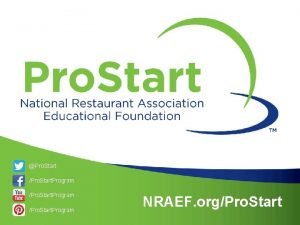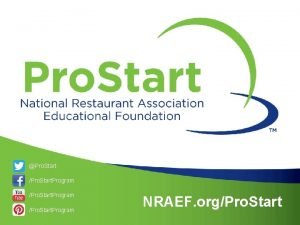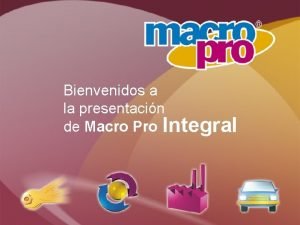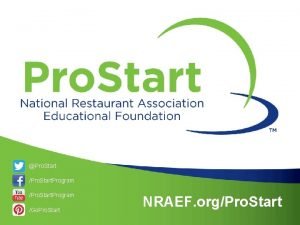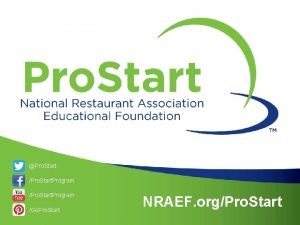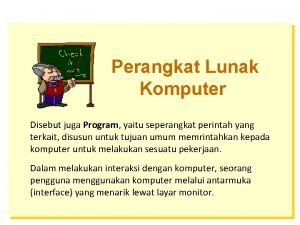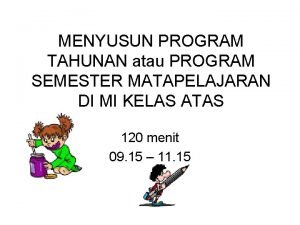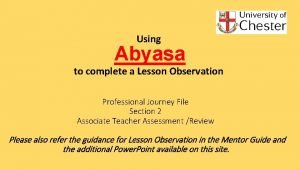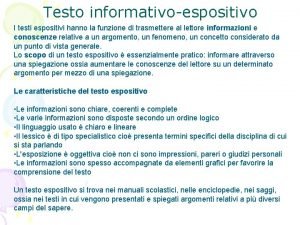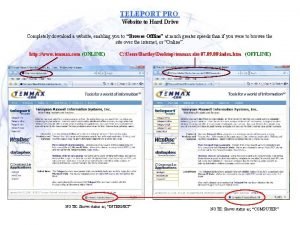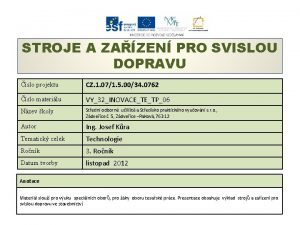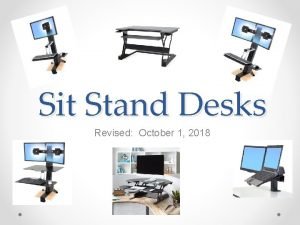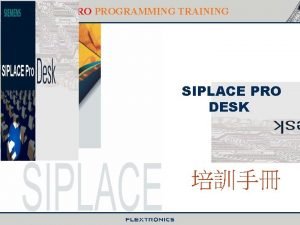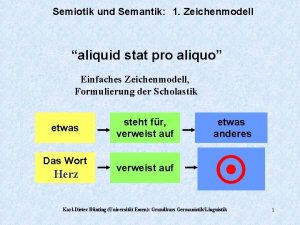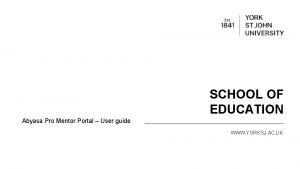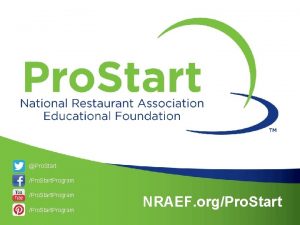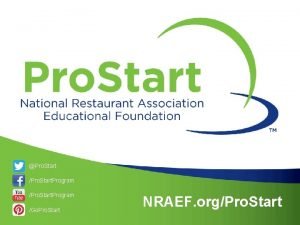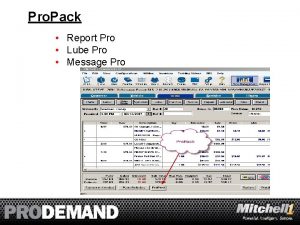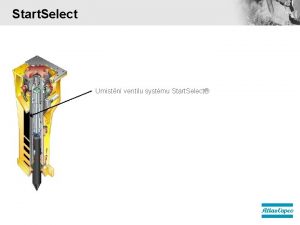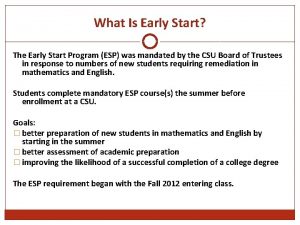Pro Start Pro Start Program NRAEF orgPro Start
















































- Slides: 48

@Pro. Start /Pro. Start. Program NRAEF. org/Pro. Start

2013 Invitational Student Practice Session Management Competition Caitie Eggl National Pro. Start Coordinator November 16, 2012

Why Participate • Scholarship opportunities • In 2012, $1. 4 million was awarded to the top 5 teams in both the management and culinary competitions at the National Pro. Start Invitational® • Networking for students and educators

Competition Elements • The Management Competition is divided into four events: written proposal, verbal presentation, visual display and critical thinking • The events are weighted as follows: • • Written Proposal – 55 points Verbal Presentation – 55 points Critical Thinking – 50 points Visual Display – 15 points

Team Members • Current high school students enrolled in Pro. Start • Maximum of 4 students – 1 alternate allowed in case of injury/illness • May only compete for two years (may compete on both culinary and management over those two years)

Assistance • Mentors and educators only assist in competition prep • May not prepare any of the materials themselves • Limited to acting as sounding board and critiquing practice presentations • Proposal should be unique work each year

Written Proposal

Preparation • Fictitious city description includes: – Population – Major attractions – Prominent businesses • Students will develop a written proposal including: – Restaurant concept – Menu – Marketing launch

Restaurant Concept • Concept description - basic information such as: – Type of establishment – Type of cuisine served – Hours of operation, etc.

Restaurant Concept • Interior diagram – identify flow/features • FOH (host stand, bus stations, etc. ) • BOH (safety features, equipment to cook the items on the menu, etc. ) • Organizational chart – capture all the personnel essential to running the restaurant (from managers to janitorial staff)

Menu • Descriptions of 9 menu items – Penalty if submit more • For 3 items, must include recipes and costing – Can be done in conjunction with culinary team • Prepare and submit photos of the same 3 items • Submit a sample of menu presentation

Marketing • Develop 2 marketing tactics to launch the restaurant • Penalty for submitting more • Include description, goal and budget • Submit a sample of their tactics – Such as layout of ad, slogan for t-shirt, etc. • Alcohol-related activities or promotions cannot be used

Scoring • Judges looking for: – Concept creativity – How well thought through their concept – How well executed on the requirements • Electronic draft of the written proposal must be submitted in advance – The draft will not be judged • Written proposal evaluated by verbal presentation judges – The only exception is the recipe & costing judge • Worth a total of 55 points

Verbal Presentation

Preparation • Develop 10 -minute presentation based on written proposal – Treat judges like a panel of potential investors • Presentation should pull out relevant information investors would be interested in – Only use Power. Point and may not embed any bells and whistles (such as video, sound, etc. ) – May only use the “no transition” option for slide transitions – May use a custom design template

Delivery • Have 10 minutes to present their concept, menu and marketing – 1 -point penalty per minute over the 10 -minute limit, with disqualification after 4 minutes over – Visible clock to keep track of time • Judges have 5 additional minutes to ask the team questions – Help determine that students did all the work

Delivery • Each team member must have substantial speaking role – 5 -point penalty per student without substantial speaking role • Will use projector and screen • Teams check-in presentation on a flash drive – Work off this copy on the event computer • The verbal presentation is open to the public

Scoring • Judges looking for: – Public speaking skills – How well team works together – How well pulled out pertinent information • Q & A will focus solely on presentation and proposal • Worth a total of 55 points

Visual Display

Preparation • Build visual display that tells the story of concept • Include relevant information (and samples) from the concept, menu and marketing • Restricted in size and material of display • All supporting materials must be attached to board – Cannot exceed dimensions of the display board – Electronics such as tablets, netbooks, cell phones, smart phones, mp 3 players and digital picture frames prohibited – Only exception is a display copy of the written proposal


Delivery • Check in their visual display prior to competition • Must use display during verbal presentation • After verbal presentation, set up display in critical thinking area

Scoring • Judges evaluating: – Whether visual display accurately and creatively conveys the concept • 2 judges evaluate visual display • Worth a total of 15 points

Critical Thinking

Scenarios • Evaluated on critical thinking skills • Judges present teams with mini-scenarios from four categories, such as safety & sanitation, customer relations, human resources & staffing, marketing, menu development & design, concept knowledge • Categories determined each year by SRA and NRAEF – All teams evaluated on same four categories, but with unique scenarios

Delivery • Scenarios presented after verbal presentation • Work together to come up with solutions on the spot • Answers must relate to restaurant concept • Open to the public

Scoring • Judges evaluating – Understanding of management concepts – Problem solving – Teamwork • 4 judges total • Worth a total of 50 points

Workplace Safety • How address chemical and physical hazards? • Follow the proper protocol to prevent or mitigate legal action? • Safety a component of every decision they make? • Example: We see that you have a line cook position - while the line cook is carrying your signature soup, he slips in a puddle of water by the dish area. What do you do?

Food Safety & Sanitation • HACCP plan in place? • Follow the proper protocol to prevent or mitigate legal action? • Sanitation a component of every decision they make? • Example: While pulling out the beef for your signature ribeye, your prep cook notices that the walk-in seems a bit warm. What do you do?

Customer Relations • Is customer always foremost in teams’ minds? • Is Rule of 10 taken into consideration? • Does team follow up with guests? • Example: We see that mashed potatoes are the star item on your menu, how will you handle customer relations if your supplier does not deliver potatoes?

Human Resources & Staffing • Disciplinary action follow standard protocol and legal procedures? • How are policies communicated to employees? • Balance need to properly staff restaurant vs. cost efficiency? • Look for creative solutions to staffing problems? • Cross-training factor into solutions? • Example: You have a party booked in your kid’s party room, and your lead party server calls off – what do you do?

Marketing • Consider impact of all communications on sales, staffing and public perception? • Crisis communications plan in place? • Whole organization a part of marketing plan? • Example: In the coupon you printed in the newspaper, you forgot to put an expiration date. Two months later, a table tries to redeem it – what do you do?

Menu Development & Design • How do all parts of the menu work together? • Menu design represent the concept and menu? • How do the prices on the menu relate to each other? • Example: You don’t sell as much of the filet as you anticipated on Friday night, what will you do with the extra filets?

Concept Knowledge • How does a quickservice restaurant operate vs. fine dining? • How does location of restaurant impact all other areas? • Example: Due to your location you serve a high volume during lunch. However, dinner tickets are down. What can you do to increase dinner volume?

Tips • Don’t dissect what led to current problems, address how to solve them – Instead of playing blame game, deal with situation as it is and put plans in place to prevent repeats • Work as team to solve the challenges – If a teammate stumbles, jump in and help him/her out

Resources • • • Map to curriculum Listing of online resources Samples Training presentations Training videos

Strategies for Success

Keys to Success • • • Understand the rules Find a mentor Practice Use your resources Professionalism

Understand the Rules • Losing by a technicality is heartbreaking • Hold students accountable, but provide guidance • When in doubt, ask • Review score sheets

Understand the Rules • Allowable information – No financials (except Marketing Budget) • Required materials – Costing packets – Visual display – Power. Point • Menu items and marketing tactics – 9 menu items – 2 marketing tactics

Find a Mentor • Industry mentors provide important viewpoint • Should advise, not dictate • Strategies to secure mentors

Practice!! • • Most important key to success Simulate competition experience Varied audiences Use score sheets

Critical Thinking Scenarios • Ask mentors to provide challenges they face on a daily basis and doomsday challenges – Present solutions to mentors • Industry people love to tell horror stories – use it to your advantage! • Use your own observations – what have you witnessed happen in a restaurant? • Industry publications – Nation’s Restaurant News, etc.

Verbal Presentation • Develop public speaking skills • Practice presenting solutions to anyone who will listen, including other educators, school administrators, etc.

Professionalism • • On-time arrival Uniform Remember that judges are always watching Confidence

Questions?

Get Involved! Call (800) 765 -2122, ext. 5376 Visit NRAEF. org/Pro. Start Email getinvolved@NRAEF. org

@Pro. Start /Pro. Start. Program /Go. Pro. Start NRAEF. org/Pro. Start
 Orgpro
Orgpro Orgpro
Orgpro Macro pro
Macro pro Start pro
Start pro Start pro
Start pro Start pro
Start pro It's gotta start somewhere it's gotta start sometime
It's gotta start somewhere it's gotta start sometime Jumpstart pediatric triage
Jumpstart pediatric triage Pros and cons of child care centers
Pros and cons of child care centers Hitrust risk management framework
Hitrust risk management framework Differences between sequential and event-driven programming
Differences between sequential and event-driven programming Perangkat lunak
Perangkat lunak Menyusun program tahunan dan program semester
Menyusun program tahunan dan program semester Microsoft exel merupakan program aplikasi
Microsoft exel merupakan program aplikasi Microsoft excel merupakan aplikasi pengolah
Microsoft excel merupakan aplikasi pengolah Program ms word merupakan program …. *
Program ms word merupakan program …. * Webmailer hosteurope
Webmailer hosteurope Napa canada prolink
Napa canada prolink Hr pro payroll
Hr pro payroll Waste pro rewards
Waste pro rewards Desztilláló készülék részei
Desztilláló készülék részei Ecosim pro
Ecosim pro Ctworks
Ctworks Abyasa chester
Abyasa chester Us pro soccer organization
Us pro soccer organization ácidos orgánicos
ácidos orgánicos Testo informativo esempio
Testo informativo esempio Teleport pro
Teleport pro Test out pc pro
Test out pc pro Stroje pro dopravu tuhých látek
Stroje pro dopravu tuhých látek Dsd 1 pro
Dsd 1 pro Staples varidesk
Staples varidesk Siplace pro desk
Siplace pro desk Download sequel pro for windows
Download sequel pro for windows Aliquid stat pro aliquo
Aliquid stat pro aliquo Abyasa pro
Abyasa pro Abyasa pro
Abyasa pro Pro bnp referentne vrednosti
Pro bnp referentne vrednosti Pro rodeo
Pro rodeo Note de cadrage tms pro exemple
Note de cadrage tms pro exemple Vzorce a+b
Vzorce a+b Pro rodeo
Pro rodeo Fischertechnik robo pro programmierung
Fischertechnik robo pro programmierung Unloaded image
Unloaded image Rheem residential water heaters
Rheem residential water heaters Kognitivní funkce
Kognitivní funkce Neutronics refrigerant analysis
Neutronics refrigerant analysis Conclusion reciclaje
Conclusion reciclaje Stage edpi
Stage edpi
